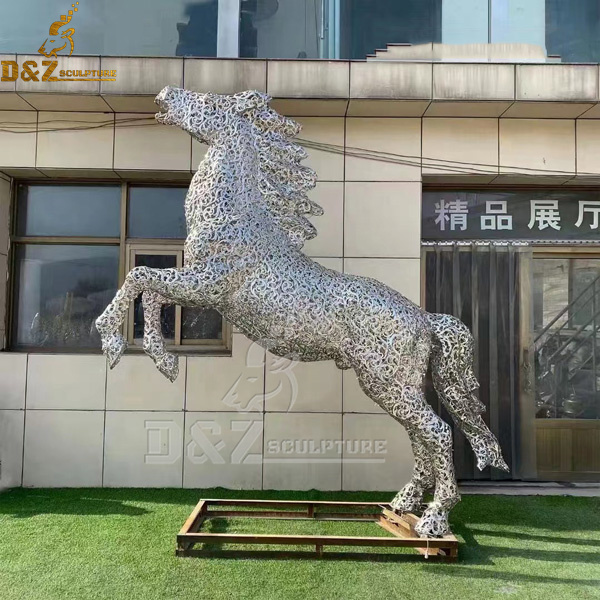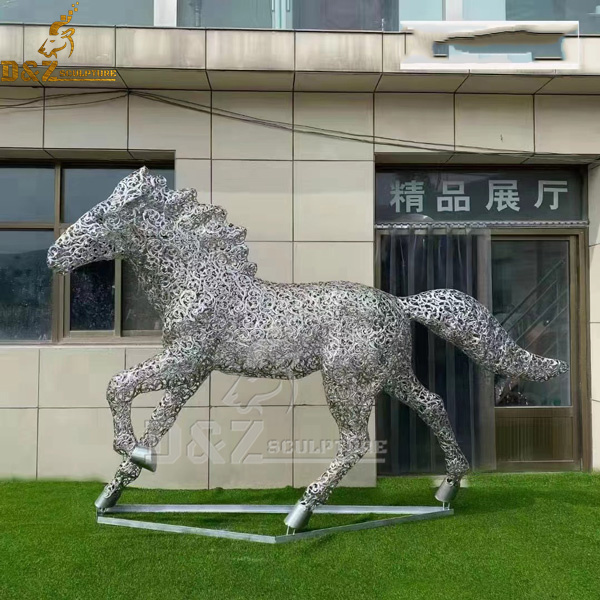life size metal moden horse sculpture for garden decoration DZM 1068
metal modern horse sculpture for garden
1.Products NO.: DZM-1068
2.Material: Stainless steel /#304
3.Thickness:more than 2mm
4.Size:Custom made depends on your prefer
5.Color: custom made depends on your prefer
6.Package: strong wooden cases
7.Service: Free design, creation, door to door delivery
8.advancement: Factory directly
9.Guarantee: more than 30 years
10.MOQ: 1pc
Metal horse sculpture
In the long history of human beings, horses are indeed the earliest animals that humans have known and domesticated. As we all know, in the farming era, horses have established indelible achievements as an important production and means of transportation in the field of human production and life; in the period of war filled with gunpowder smoke, horses acted to assist human beings; in ancient times of peace and prosperity, horses trained soldiers in the army. and court entertainment tools, participating in ancient polo games or hunting activities; in modern leisure tourism and sports arena, horses still accompany human beings to pursue higher and farther goals, and move forward together with people.

Throughout the development of human society, the irreplaceable role of horses has accelerated the integration of human races and promoted national unity, from taming prey in prehistoric times to transportation vehicles, from assistants in life to machines in war. In the migration and expedition of human beings, chess is the life principle of nomads, and horses have always gone through every major change and historical event with human beings. For thousands of years, no matter how the times change or how science and technology develops, people and horses have always been side by side, and the horse culture created together has always accompanied the historical process of the Chinese nation, and has played a huge role in promoting and promoting. Culture is an important part of traditional Chinese culture, the main body of grassland culture, and the symbol of animal husbandry civilization. As the hometown of Mongolian horses, Inner Mongolia promotes horse culture, studies horse science, promotes horse industry, and develops Mongolian horse spirit is the historical mission entrusted by the times.

Culture belongs to cultural studies from the perspective of discipline, but the scope involved is not limited to – disciplines, but also involves many fields such as science, literature and art, sports, tourism, medicine, and military. If culture is defined as the sum of spiritual wealth and material wealth created by human beings, then “horse culture refers to the sum of material and spiritual wealth related to horses created in the historical practice of human society”.
In addition to people’s interest and development of horse’s biological functions, it also includes horse-related thoughts, behaviors, customs, and related institutional policies, which can be divided into horse behavior culture, horse material culture, horse spiritual culture, and horse culture. Institutional culture, etc. The most abundant content in “camelization” is the folk customs of horse-training and horse-riding people, including human’s understanding of horses, domestication, service, literature, art and sports activities related to horses. In different regions and in the same ethnic group, deception has affected many aspects such as human living habits, religious beliefs, and national culture in different forms, connotations, and degrees. Chinese horse culture has extremely rich connotations, including horse learning, horse training, code, pastoralism, horse learning and customs, Qi sucking its ornaments, arrogance, political system, and horse literature and art.
my country is the birthplace of horse breeds in the world and one of the earliest countries to raise horses. The image of a horse in my country was first seen in oracle bone inscriptions, and then appeared on bronze wares. In Xinjiang, my country, there are still wild horses that are more precious than pandas. Wild horses are the ancestors of domestic horses, and they have lived in our country for millions of years. But it was domesticated by our ancestors at the latest time, about four or five thousand years ago, that is, the late Neolithic period.


Reviews
There are no reviews yet.